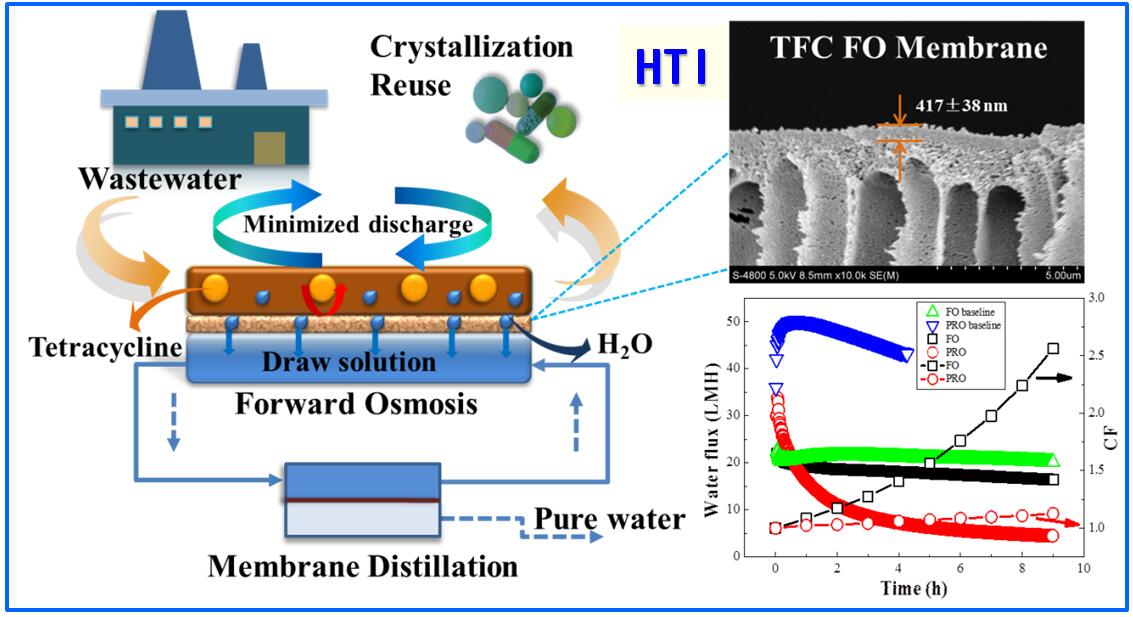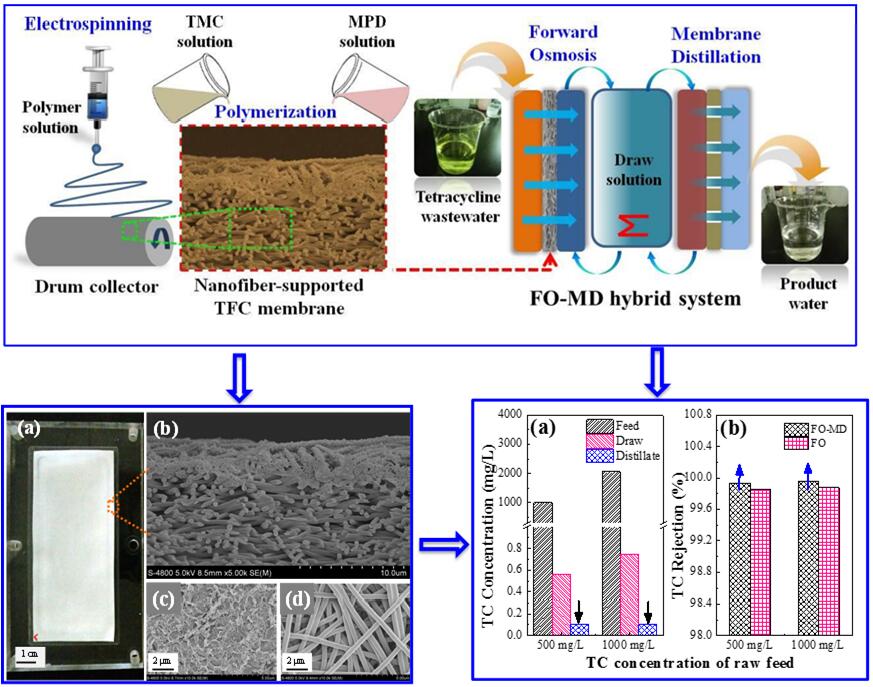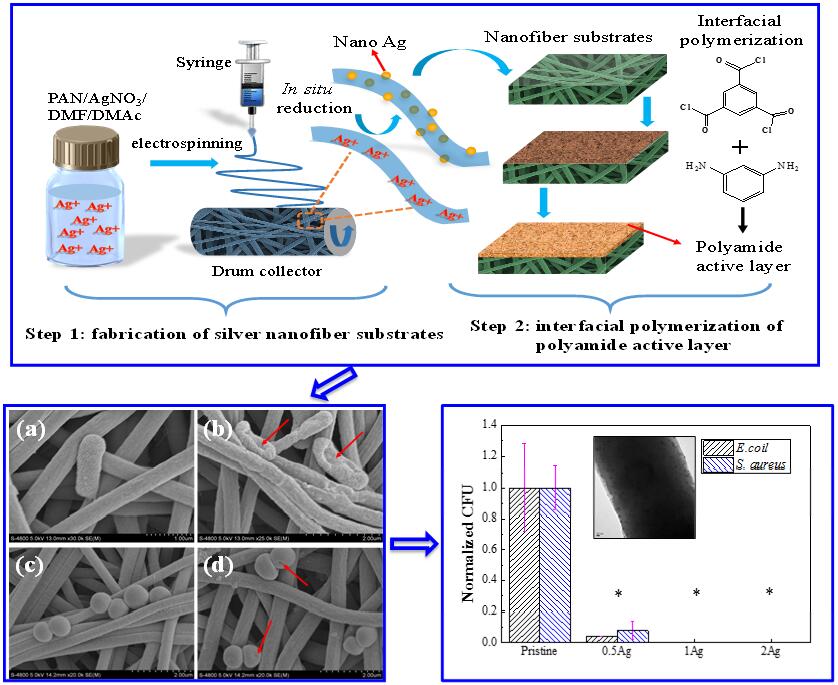Global water scarcity is one of the greatest crises around the world. By 2025, nearly two thirds of the world's population lives in water deficient area, and millions of people die from waterborne diseases in unsafe water. Exploitation of effective and lower-cost methods for water production and water treatment is addressed urgently. Membrane separation technology appeared in the 1920s, which was considered as "one of the most promising technologies in the 21st century". Membrane technology could resolve issues that the traditional methods fail to resolve, and it gained popularity in water and wastewater treatment. The research group led by Prof. Yu-Ming Zheng in Institute of Urban Environment, Chinese Academy of Sciences is major in developing new membrane materials and its application in antibiotic wastewater treatment. Forward osmosis (FO) is a new membrane, which process a natural process that utilizes an osmotic pressure difference across a semi-permeable membrane to draw water from a dilute solution into a concentrated one. Compared with pressure-driven membrane processes, FO possesses some unique advantages such as low energy consumption, low membrane fouling and mild operating conditions. Recently, FO has been gaining popularity in power generation, desalination, wastewater treatment and food processing. To minimize the risk of antibiotic wastewater generated by the pharmaceutical industries, we applied the commercial thin film composite FO membrane for the recoverable separation of tetracycline TC from wastewater. The obtained results showed that the water flux and TC rejection achieved were over 20 LMH and 99.0%, respectively. High TC concentration factor (CF) of 2.6 was obtained in FO mode, indicating the concentrated could be recovered by conventional crystallization. This study has been published in Separation and Purification Technology (Sep. Purif. Technol. 2015,153:76-83).

TC in wastewater can be concentrated by FO process, and the highly concentrated TC could be recovered by conventional crystallization
FO membrane is the most important factor in the application of FO technology. However, FO has not been applied on a large-scale due to low water flux, serious internal concentration polarization (ICP) and membrane fouling. Thus, to develop a novel high performance FO membrane, which can alleviate ICP, improve the water flux and enhance anti-fouling ability without sacrificing the selectivity of membrane, has become a challenging topic. As the development of nanotechnology, the electrospun nanofiber membrane nanofiber membrane is expected to solve this issue. Due to its interconnecting pore structure with high porosity and large specific surface area, the electrospun nanofiber membrane might be as support of FO membrane for decreasing mass transfer resistance and improving water flux. Thus, the group employed electrospinning to fabricate nanofiber support, on which a thin polyamide (PA) active layer was deposited to form a thin film composite FO membrane. Future, the as prepared FO membrane was applied for simulated antibiotic (TC) wastewater treatment in a FO-MD (membrane distillation) hybrid system. The results showed that such support has a low structural parameter (S = 168 μm) owing to its scaffold-like structure with interconnecting pores, thereby alleviating ICP. The water flux of PA/PAN-eTFC membrane could achieve over 41 LMH using 2 M NaCl as draw solution. Meanwhile, TC removal in the FO-MD hybrid system was higher than 99.9% and 15%-22% water recovery can be obtained. This study has been published in Journal of Membrane Science (J. Membr. Sci., 2017, 523, 205-215).

Electrospinning and polymerization were used to prepare self-sustained thin film composite forward osmosis membranes, which processed the low S and excellent permselectivity; the prepared FO membrane can applied in a FO-MD hybrid system for simulated TC wastewater treatment and water production
In order to further enhance anti-biofouling activity, we prepared an antimicrobial electrospun nanofiber mat with silver nanoparticles (AgNPs) was synthesized to serve as supports for thin film composite FO membranes. Specifically, AgNPs were formed via in stiu method, which monodispersed on/within the nanofibers with diameter of about 10 nm. The corresponding supported thin-film nanocomposite possessed outstanding hydrophilicity, resulting in high water fluxes. Leaching test showed that the AgNPs could act as a silver ions reservoir and slowly release silver ions into the solution, which endowed the FO membranes with excellent antibacterial activity for E. coli and S. aureus. This study has been published in NDUSTRIAL & ENGINEERING CHEMISTRY RESEARCH (Ind. Eng. Chem. Res. 2019, 58, 984-993).

Silver/polyacrylonitrile nanofiber thin-film nanocomposite FO membranes can inhibit the activity of E. coli (96%) and S. aureus, alleviating membrane biofouling